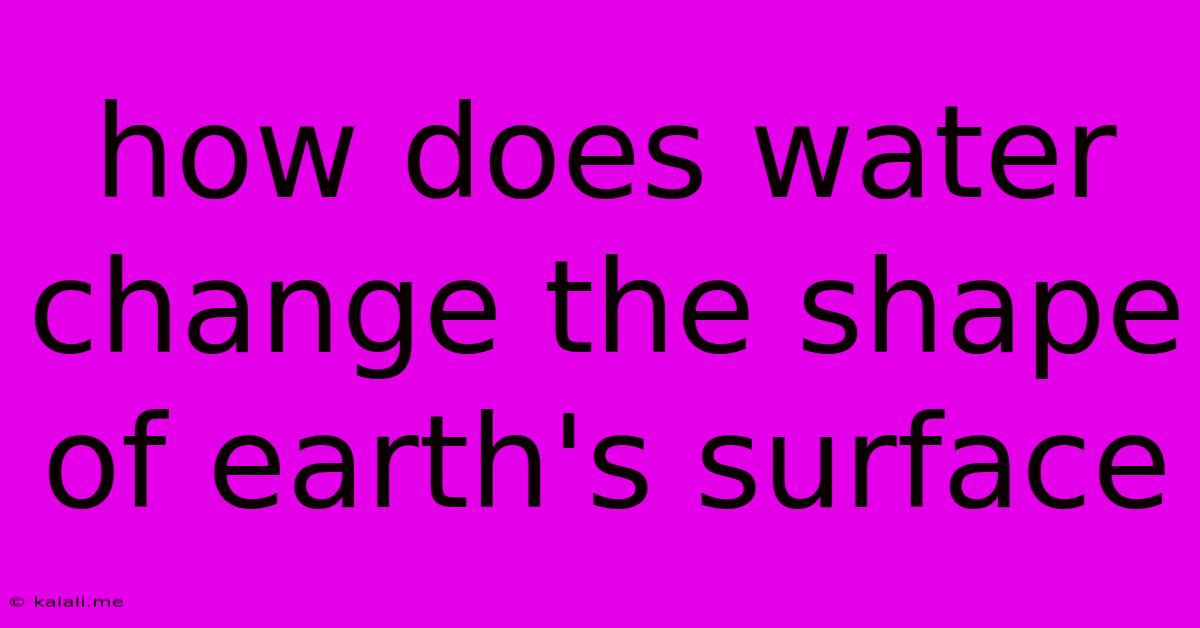How Does Water Change The Shape Of Earth's Surface
Kalali
May 09, 2025 · 3 min read

Table of Contents
How Does Water Shape the Earth's Surface? The Powerful Sculptor
Water, in its various forms, is a relentless sculptor, constantly reshaping the Earth's surface over vast timescales. From the gentle erosion of a raindrop to the catastrophic power of a tsunami, the influence of water on our planet's geology is undeniable. This article will explore the diverse ways water alters the Earth's topography, revealing its role as a powerful force of change.
Understanding the Processes:
Water's ability to shape the land stems from several key processes:
- Erosion: This is the gradual wearing away of rock and soil by the action of water. Rain, rivers, ocean waves, and even glaciers are all agents of erosion. The force of flowing water picks up sediment (sand, silt, and other particles) and carries it away, smoothing out surfaces and carving out valleys.
- Transportation: Eroded material is not simply removed; it's transported to new locations. Rivers carry sediment downstream, eventually depositing it in lakes, oceans, or deltas. Ocean currents distribute sediment across vast distances, shaping coastlines and building underwater features. Glaciers, acting as massive conveyor belts of ice and rock, transport huge quantities of debris.
- Deposition: This is the process by which transported sediment is laid down. When the energy of water decreases (e.g., a river entering a lake), it loses its ability to carry sediment, leading to deposition. This process builds up landforms like deltas, alluvial fans, and beaches. It also creates fertile plains, crucial for agriculture.
- Weathering: While not directly involving the movement of water, weathering is a crucial precursor to erosion. Water, particularly rainwater, facilitates chemical and physical weathering processes that break down rocks, making them more susceptible to erosion. Freezing and thawing cycles (frost wedging) are particularly effective at breaking rocks apart.
Specific Examples of Water's Shaping Power:
Let's delve into some specific examples of how water's various forms sculpt the Earth:
1. Rivers: Rivers are powerful agents of erosion and transportation. They carve deep valleys, create meandering channels, and deposit sediment to form deltas and floodplains. The Grand Canyon, for instance, is a testament to the erosive power of the Colorado River over millions of years.
2. Oceans: Ocean waves constantly batter coastlines, eroding cliffs and beaches. The relentless pounding of waves shapes sea caves, arches, and stacks. Ocean currents also transport vast amounts of sediment, building up beaches and shaping underwater landscapes.
3. Glaciers: Glaciers are massive rivers of ice that carve out U-shaped valleys, leaving behind moraines (piles of rock and debris) and other distinctive landforms. The fjords of Norway, for example, are stunning examples of glacial erosion.
4. Rainfall: Even seemingly gentle rainfall contributes significantly to erosion over time. Raindrops dislodge soil particles, initiating the process of erosion, especially on slopes. Sheetwash, the relatively uniform flow of water across a surface, can also significantly erode soil.
The Impact on Human Life:
The shaping power of water has profound implications for human life:
- Agriculture: Deposition of fertile sediments creates productive land for agriculture.
- Water Resources: Rivers and groundwater are vital sources of freshwater.
- Coastal Development: Understanding coastal erosion is essential for planning coastal settlements and infrastructure.
- Natural Hazards: Floods, landslides, and tsunamis, all related to water, pose significant risks to human populations.
Conclusion:
Water's impact on the Earth's surface is undeniable. Its constant interaction with the land, through erosion, transportation, and deposition, shapes mountains, valleys, coastlines, and countless other features. Understanding these processes is crucial not only for appreciating the Earth's dynamic nature but also for managing its resources and mitigating the risks associated with water-related hazards. The ongoing dance between water and land continues to sculpt our planet, a testament to the power of nature's most abundant and versatile resource.
Latest Posts
Latest Posts
-
How Many Feet Is 125 Cm
May 09, 2025
-
How Many Heart Chambers Does A Bird Have
May 09, 2025
-
How Much Is 2 3 In Ml
May 09, 2025
-
6 Is What Percent Of 80
May 09, 2025
-
Cuanto Es 160 Cm En Pulgadas
May 09, 2025
Related Post
Thank you for visiting our website which covers about How Does Water Change The Shape Of Earth's Surface . We hope the information provided has been useful to you. Feel free to contact us if you have any questions or need further assistance. See you next time and don't miss to bookmark.